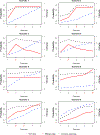A utility-based Bayesian optimal interval (U-BOIN) phase I/II design to identify the optimal biological dose for targeted and immune therapies
- PMID: 31621952
- PMCID: PMC7927960
- DOI: 10.1002/sim.8361
A utility-based Bayesian optimal interval (U-BOIN) phase I/II design to identify the optimal biological dose for targeted and immune therapies
Abstract
In the era of targeted therapy and immunotherapy, the objective of dose finding is often to identify the optimal biological dose (OBD), rather than the maximum tolerated dose. We develop a utility-based Bayesian optimal interval (U-BOIN) phase I/II design to find the OBD. We jointly model toxicity and efficacy using a multinomial-Dirichlet model, and employ a utility function to measure dose risk-benefit trade-off. The U-BOIN design consists of two seamless stages. In stage I, the Bayesian optimal interval design is used to quickly explore the dose space and collect preliminary toxicity and efficacy data. In stage II, we continuously update the posterior estimate of the utility for each dose after each cohort, using accumulating efficacy and toxicity from both stages I and II, and then use the posterior estimate to direct the dose assignment and selection. Compared to existing phase I/II designs, one prominent advantage of the U-BOIN design is its simplicity for implementation. Once the trial is designed, it can be easily applied using predetermined decision tables, without complex model fitting and estimation. Our simulation study shows that, despite its simplicity, the U-BOIN design is robust and has high accuracy to identify the OBD. We extend the design to accommodate delayed efficacy by leveraging the short-term endpoint (eg, immune activity or other biological activity of targeted agents), and using it to predict the delayed efficacy outcome to facilitate real-time decision making. A user-friendly software to implement the U-BOIN is freely available at www.trialdesign.org.
Keywords: immunotherapy; optimal biological dose; phase I/II; targeted therapy; utility-based design.
© 2019 John Wiley & Sons, Ltd.
Figures





Similar articles
-
Adaptive phase I-II clinical trial designs identifying optimal biological doses for targeted agents and immunotherapies.Clin Trials. 2024 Jun;21(3):298-307. doi: 10.1177/17407745231220661. Epub 2024 Jan 11. Clin Trials. 2024. PMID: 38205644 Free PMC article. Review.
-
TITE-BOIN12: A Bayesian phase I/II trial design to find the optimal biological dose with late-onset toxicity and efficacy.Stat Med. 2022 May 20;41(11):1918-1931. doi: 10.1002/sim.9337. Epub 2022 Jan 31. Stat Med. 2022. PMID: 35098585 Free PMC article.
-
Phase I/II dose-finding design for molecularly targeted agent: Plateau determination using adaptive randomization.Stat Methods Med Res. 2018 Feb;27(2):466-479. doi: 10.1177/0962280216631763. Epub 2016 Mar 17. Stat Methods Med Res. 2018. PMID: 26988926
-
TITE-BOIN-ET: Time-to-event Bayesian optimal interval design to accelerate dose-finding based on both efficacy and toxicity outcomes.Pharm Stat. 2020 May;19(3):335-349. doi: 10.1002/pst.1995. Epub 2019 Dec 12. Pharm Stat. 2020. PMID: 31829517
-
BOIN: a novel Bayesian design platform to accelerate early phase brain tumor clinical trials.Neurooncol Pract. 2021 Jun 11;8(6):627-638. doi: 10.1093/nop/npab035. eCollection 2021 Dec. Neurooncol Pract. 2021. PMID: 34777832 Free PMC article. Review.
Cited by
-
A Bayesian pharmacokinetics integrated phase I-II design to optimize dose-schedule regimes.Biostatistics. 2024 Dec 31;26(1):kxae034. doi: 10.1093/biostatistics/kxae034. Biostatistics. 2024. PMID: 39275895
-
A Novel Adaptive Design Approach for Early-Phase Clinical Trials to Optimize Vaccine Dosage.China CDC Wkly. 2025 Apr 25;7(17):592-598. doi: 10.46234/ccdcw2025.097. China CDC Wkly. 2025. PMID: 40376256 Free PMC article.
-
Adaptive phase I-II clinical trial designs identifying optimal biological doses for targeted agents and immunotherapies.Clin Trials. 2024 Jun;21(3):298-307. doi: 10.1177/17407745231220661. Epub 2024 Jan 11. Clin Trials. 2024. PMID: 38205644 Free PMC article. Review.
-
Advancing Effective Clinical Trial Designs for Myelofibrosis.Hematol Oncol Clin North Am. 2021 Apr;35(2):431-444. doi: 10.1016/j.hoc.2020.12.009. Hematol Oncol Clin North Am. 2021. PMID: 33641878 Free PMC article. Review.
-
BOIN Suite: A Software Platform to Design and Implement Novel Early-Phase Clinical Trials.JCO Clin Cancer Inform. 2021 Jan;5:91-101. doi: 10.1200/CCI.20.00122. JCO Clin Cancer Inform. 2021. PMID: 33439726 Free PMC article.
References
-
- Nakashima K, Shimada H, Ochiai T, et al. Serological identification of TROP2 by recombinant cDNA expression cloning using sera of patients with esophageal squamous cell carcinoma. International journal of cancer 2004; 112(6): 1029–1035. - PubMed
-
- Ni IBP, Zakaria Z, Muhammad R, et al. Gene expression patterns distinguish breast carcinomas from normal breast tissues: the Malaysian context. Pathology-Research and Practice 2010; 206(4): 223–228. - PubMed
-
- Liu S, Yuan Y. Bayesian optimal interval designs for phase I clinical trials. Journal of the Royal Statistical Society: Series C (Applied Statistics) 2015; 64(3): 507–523.
-
- Thall PF, Russell KE. A strategy for dose-finding and safety monitoring based on efficacy and adverse outcomes in phase I/II clinical trials. Biometrics 1998: 251–264. - PubMed
Publication types
MeSH terms
Grants and funding
LinkOut - more resources
Full Text Sources
